The Toyota TS030 Hybrid was the successor to the iconic TS010 and TS020 race cars that participated in the 24 Hours of Le Mans with podium success during the 1990s. The abbreviation ‘TS’ stands simply for ‘Toyota Sport’.
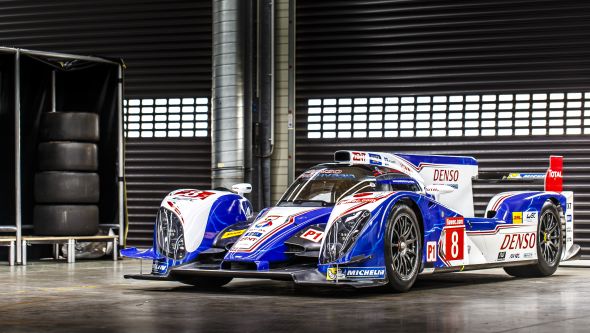
Toyota was the first manufacturer to confirm its participation in the FIA World Endurance Championship (WEC) using a hybrid powertrain, emphasising the pioneering approach to a technology that, at the time, had seen five million Toyota hybrid vehicles sold worldwide.

The Toyota TS030 Hybrid was immediately successful, winning three of the six rounds it competed in during 2012, including the final two events of the season. It also set a new LMP1 lap record at Silverstone that season.
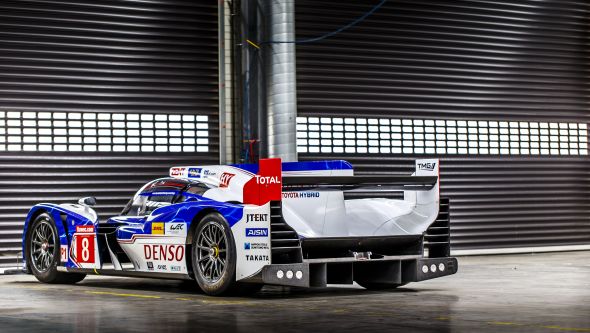
The car featured a carbon fibre LMP1 chassis developed and produced by Toyota Motorsport GmbH (TMG) in Cologne, Germany, where the race team is based. TMG is the former home of Toyota’s World Rally and Formula 1 works teams, and was responsible for the design and operation of the TS020 (GT-One) Le Mans car in 1998-99.
TMG combined works motorsport participation with being a high-performance engineering services provider to third party companies, as well as the Toyota family.
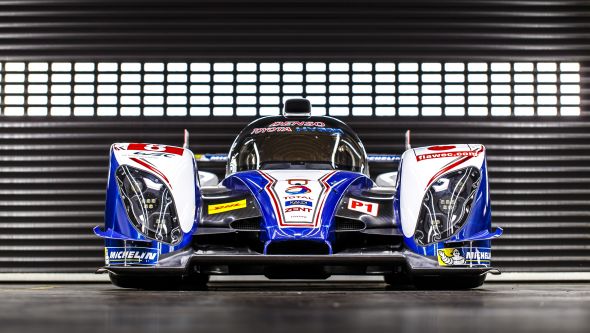
First unveiled in the 2012 season when it appeared in selected rounds of the WEC, the Toyota TS030 Hybrid was subsequently fine-tuned for the 2013 season ahead of new regulations due to be enforced in 2014. Development work was focused on the powertrain, chassis and aerodynamics to improve power, efficiency, management of component usage and reliability.
Meanwhile, the livery was almost identical to the previous year, save for a new silver roof and yellow Michelin logos. The shape of the rear wing, however, was revised, featuring a single support at each side.

Designed to deliver maximum performance, the revised THS-R (Toyota Hybrid System – Racing) powertrain featured a 3.4-litre normally-aspirated V8 petrol engine developing 530bhp along with super capacitor-based hybrid technology developed by official team partner Nisshinbo.
The hybrid system used a front motor produced by Aisin AW and a rear motor developed by official team partner Denso. Working within regulations at the time, the hybrid system was limited to recovering a maximum of 500kJ between braking zones while restricting deployment – in this case, an additional boost of 300bhp under acceleration – to only two wheels.
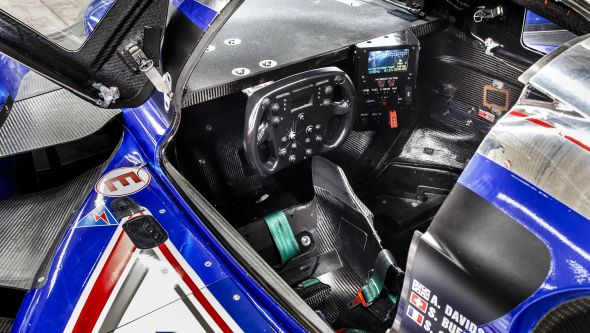
Toyota TS030 Hybrid: debut in 2012 WEC
The TS030 Hybrid was supposed to make its competitive debut in May 2012 at the Six Hours of Spa, which was the second event in that year’s FIA World Endurance Championship. Unfortunately, an accident during testing forced Toyota Racing to postpone the car’s race debut until the following month’s Le Mans 24 Hours.
Although the car was painted red, white and black with blue trim during testing, the definitive race livery reversed this colour scheme, being predominantly blue, white and black with red trim. It harked back to the colours used on the majority of Toyota’s Le Mans racing cars from 1985 to 1993.
The blue bodywork was also intended to evoke ‘hybrid blue’, as featured on all of Toyota’s range of hybrid road cars at the time.
Toyota TS030 Hybrid: 2012 Le Mans 24 Hours
At Le Mans, car #7 was driven by Alex Wurz, Nicholas Lapierre and Kazuki Nakajima, with the sister car #8 piloted by Anthony Davidson, Sebastien Buemi and Stephane Sarrazin. The latter replaced Hiroaki Ishiura, who was forced to withdraw from the line-up due to a back injury.
The brace of TS030 Hybrids started the legendary French race from third and fifth on the grid, with the #8 car in Davidson setting a best effort of 3m 24.842s and the early stages of the twice-round-the-clock race went well, with the #7 car leading on Saturday evening.
However, the race ended in difficult circumstances with the #8 car being eliminated in a heavy accident. Davidson was at the wheel when the car was hit by a back marker at Mulsanne Corner and went off into the tyre barriers at high speed.
After getting out of the car on his own, the Briton was taken to the circuit medical centre suffering from shock and back pain. Despite no obvious injuries, he was taken to hospital for checks which revealed breaks to his T11 and T12 vertebrae.
Then the #7 car suffered engine failure in the middle of the night, bringing Toyota Racing’s promising return to Le Mans to a premature end.
Toyota TS030 Hybrid: the first win beckons
Toyota Racing slimmed down to one TS030 Hybrid for the 6 Hours of Silverstone on 26 August 2012, fielding the #7 entry for Wurz, Lapierre and Nakajima and finishing a creditable second overall.
Even better was to come at the Interlagos circuit in Sao Paulo, Brazil, in September. With Nakajima busy racing in Super GT in Japan, Wurz and Lapierre shared the #7 car. They led the race from start to finish, sealing victory for the TS030 Hybrid in just its third outing.
Remarkably, it was Toyota’s first win in an international FIA-sanctioned championship since 1999, as well as its first endurance race success since 1992, when the TS010 won at Monza. The result was also regarded as a milestone in the development of Toyota’s hybrid technology for motorsport.
The team retired from the 6 Hours of Bahrain after a collision, but finished the 2012 World Endurance Championship season with a brace of victories in Fuji and Shanghai. Wurz and Lapierre ended the season joint-third in the Drivers’ World Championship, with three race victories to their name, two of them shared with Nakajima.
Toyota TS030 Hybrid: 2013 season
Toyota Racing ran two Toyota TS030 Hybrids for the 2013 WEC season. Alex Wurz, Nicolas Lapierre and Kazuki Nakajima teamed up again in the number 7 TS030 Hybrid. Meanwhile, TS030 Hybrid number 8 competed outside of Le Mans for the first time, with a team consisting of Anthony Davidson, Stéphane Sarrazin and Sébastien Buemi.
Click here for an exclusive video documentary detailing some of the history of this incredible car.
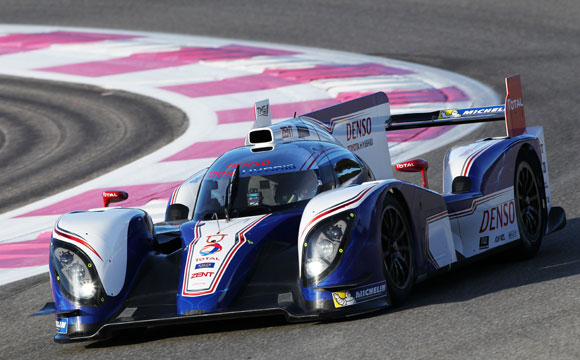
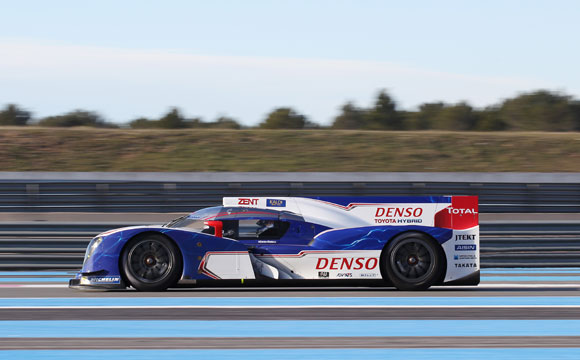
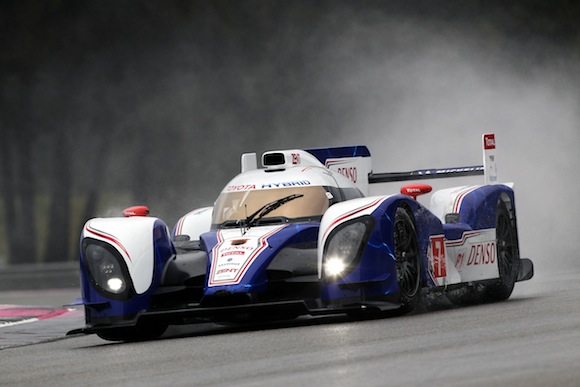
Toyota TS030 Hybrid technical specifications (2012)
Designation | TS030 Hybrid |
Type | Le Mans Prototype (LMP1) |
Bodywork | Carbon fibre composite |
Windscreen | Polycarbonate |
Gearbox | Transverse, 6spd, sequential |
Gearbox casing | Aluminium |
Driveshafts | Constant velocity tripod plunge-joint driveshafts |
Clutch | Multidisc |
Differential | Viscous mechanical locking differential |
Suspension | Independent front and rear double wishbone, pushrod-system |
Springs | Torsion bars |
Anti roll bars | Front and rear |
Steering | Hydraulically assisted |
Brakes | Dual circuit hydraulic braking system, mono-block light-alloy brake callipers front and rear |
Discs | Ventilated front and rear in carbon |
Rims | Magnesium forged wheels |
Front rims | 14.5 x 18 inch |
Rear rims | 14.5 x 18 inch |
Tyres | Michelin radial |
Front tyres | 36/71-18 |
Rear tyres | 37/71-18 |
Length | 4650mm |
Width | 2000mm |
Height | 1030mm |
Fuel capacity | 73 litres |
Powertrain | Toyota Hybrid System – Racing (THS-R) |
Engine | 90° V8 normally aspirated engine |
Fuel | Petrol |
Engine Capacity | 3.4l |
Valves | 4 |
Air restrictors | 1 x 43.3mm |
Capacitor | Nisshinbo |
Front Hybrid Motor | Aisin AW |
Rear Hybrid Motor | Denso |
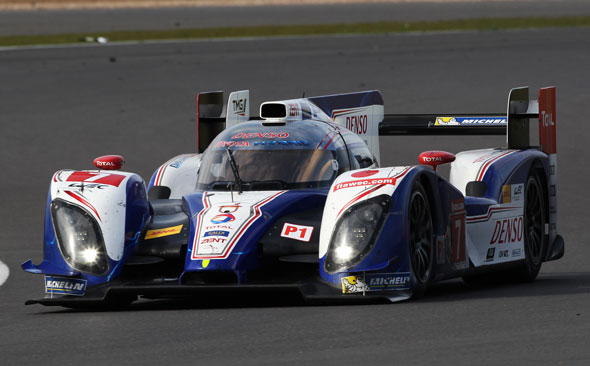


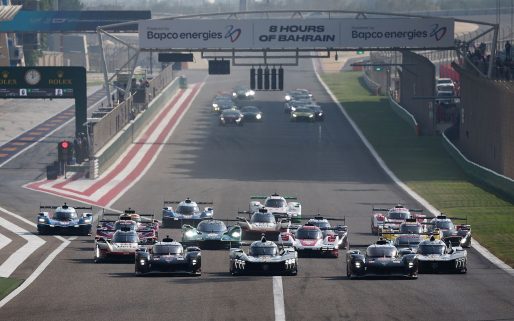

The car definitely looks better this year….I look forward to a spatre of 1-2s!